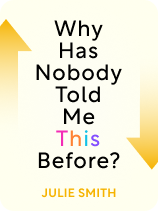

This article is an excerpt from the Shortform book guide to "Why Has Nobody Told Me This Before?" by Julie Smith. Shortform has the world's best summaries and analyses of books you should be reading.
Like this article? Sign up for a free trial here.
Are you always “in a mood,” causing those around you to walk on eggshells? Do you depend on circumstances, medication, or therapy to bring you out of it?
Dr. Julie Smith says that it’s likely that you can change your mood yourself by monitoring and adjusting four things. If you attend to your physical state, your thought patterns, your actions, and your connections with others, you can elevate your frame of mind.
Read more to learn how to change your mood with Smith’s recommendations.
How to Change Your Mood
Smith describes how a vicious cycle keeps us stuck in low moods: Our moods impact our thoughts, which impact our actions, which impact our physical health, which further brings down our moods. Smith’s four-part advice on how to change your mood can help you stop this cycle.
(Shortform note: The interplay between thoughts, feelings, and behaviors is the foundation of CBT, which calls this feedback loop the cognitive triangle. Smith has gone one step beyond the foundation of CBT to include the influence and impact on our physical health. Therapy approaches that include the body are often called somatic therapies, and in this way, Smith’s approach is integrative—blending and applying multiple therapy theories and approaches into one.)
Your physical state: Low moods can be exacerbated by fatigue, hunger, physical discomfort, insufficient exercise, poor nutrition, and an imbalance in our routines. To support your mood and emotional well-being, work to improve physical factors before addressing things like your thoughts and behaviors.
(Shortform note: In addition to normal fluctuating physical states like fatigue and hunger, low moods and depression can be caused by physical illness and other health conditions. For example, an underactive thyroid, known as hypothyroidism, is associated with depression. Low thyroid hormone levels are believed to disturb the production of mood-regulating neurotransmitters like serotonin. It’s a good idea to talk to a doctor about your depression to rule out physiological causes.)
Your thought patterns: Negative thought patterns, particularly self-critical and repetitive ones, can cause low moods. Smith recommends cultivating self-compassion to help reduce and change negative thought patterns. To tap into self-compassion, ask yourself how you would respond to someone you love who was going through the same things and then respond to yourself in the same way. You can also cut negative thought patterns off by adjusting your physical state—for example, by changing your environment or body position or even raising your hand and telling yourself, “Stop.”
(Shortform note: Tara Brach teaches a practice called RAIN, which uses your thoughts and body position to tap into self-compassion when you’re having negative thoughts and painful emotions. An acronym that outlines each step of the process, RAIN can and should be practiced whenever you find yourself stuck in a negative thought pattern. Brach recommends pausing, closing your eyes, placing a hand on your heart, and doing the following: Recognize and name the painful thought you’re having. Allow and accept the thought’s presence without judgment. Investigate what this thought may be trying to tell you or what might be causing it. Nurture yourself with an alternative, kind thought like, “I’m doing my best, and it’s good enough.”)
Your actions: Our actions feed our body and brain information about how to feel. When we experience low moods, we often avoid activities that could improve how we feel, and we tend to make short-term choices that ultimately worsen our long-term emotional state. Smith writes that to change your habits and behavior, you should change just a few things at a time. Low moods can make even small, familiar tasks overwhelming, so don’t push yourself to improve too many things at once.
(Shortform note: Aside from taking it slowly, Smith doesn’t go into detail about strategies for changing your behavior and habits for the better when you’re feeling low. In The Willpower Instinct, Kelly McGonigal outlines numerous strategies for pointing yourself away from unhelpful behaviors when you’re feeling bad, including creating a system of reminders about making different choices. For example, if you often binge-watch TV when you feel low, but you know going outside will make you feel better, you could leave a sticky note on your remote saying, “Can you go outside instead?” Such reminders would be consistent with Smith’s advice to start small, as they can help you change your behavior in trivial, easy-to-approach ways.)
Connection with others: Having positive connections with other people can have a huge positive impact on our mental well-being. Unfortunately, having low moods can make us feel like isolating ourselves from others until we feel better. Isolation can then perpetuate and exacerbate feelings of low mood and depression. Thus, Smith advises that instead of waiting until you feel like socializing, try to make time to be around others even when you don’t feel like it.
(Shortform note: In Lost Connections, Johann Hari argues that a feeling of disconnection from others is caused by social isolation, as Smith writes, but it can also happen when you’ve lost positive social status in your life—when circumstances make you feel less than other people around you. To reconnect with others socially, Hari recommends helping others, perhaps by volunteering, because caring for others eases depression. To combat the negative effects of having low social status, he suggests working to let go of your ego. One way to do so is to practice what he calls sympathetic joy—intentionally cultivating happiness for other people’s happiness.)
Exercise: Cultivate Self-Compassion
Smith explains that learning to be kind and compassionate toward yourself is an essential part of mental well-being. Let’s look at what self-compassion means to you and practice cultivating more of it.
- Reflect on what self-compassion means to you. Do you believe it’s important to be kind and patient with yourself, or do you believe you have to be hard on yourself to keep your thoughts, feelings, and behavior on track?
- Think of a time you felt stressed, anxious, angry, or frustrated this week. What kind of things did you tell yourself while you were experiencing a challenging situation? Did the thoughts you had toward yourself during that time help you feel better? Why or why not?
- Consider the same challenging time that you had this week, but now imagine that the person you love most in the world was experiencing it instead of you. How would you speak to that person to support them and see them through the difficult emotions?
- If you would support your loved one with kindness and patience, reflect and write a few sentences about why you would choose to support them this way. What is the benefit of having compassion for others?
- How might speaking to yourself with kindness, patience, and compassion be supportive in the way it’s supportive in your relationships with other people?

———End of Preview———
Like what you just read? Read the rest of the world's best book summary and analysis of Julie Smith's "Why Has Nobody Told Me This Before?" at Shortform.
Here's what you'll find in our full Why Has Nobody Told Me This Before? summary:
- Practical tips for managing difficult emotions and thoughts
- Why self-compassion is key to mental health and how you can cultivate it
- How to change your relationship with failure






